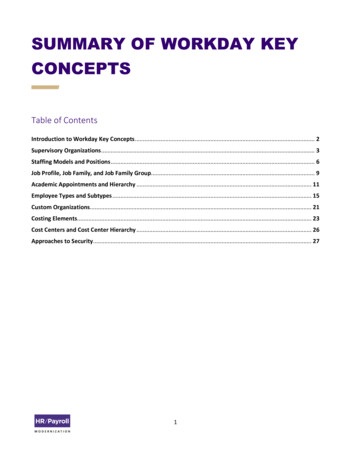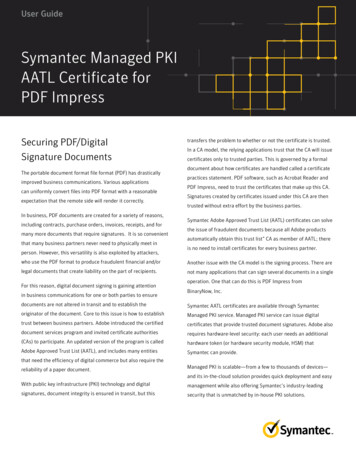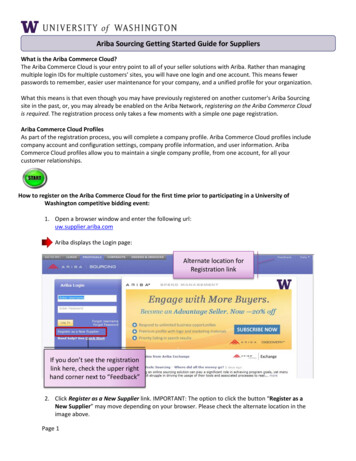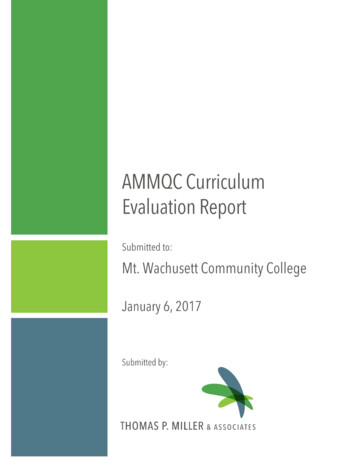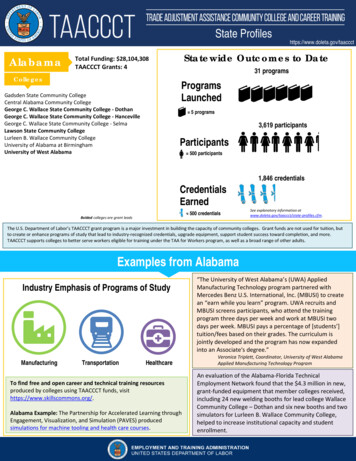
Transcription
State ProfilesAlabamaStatewide Outcomes to DateTotal Funding: 28,104,308TAACCCT Grants: 4Collegeshttps://www.doleta.gov/taaccct/31 programsProgramsLaunchedGadsden State Community CollegeCentral Alabama Community CollegeGeorge C. Wallace State Community College - DothanGeorge C. Wallace State Community College - HancevilleGeorge C. Wallace State Community College - SelmaLawson State Community CollegeLurleen B. Wallace Community CollegeUniversity of Alabama at BirminghamUniversity of West Alabama 5 programs3,619 participantsParticipants 500 participantsCredentialsEarned 500 credentialsBolded colleges are grant leads1,846 credentialsSee explanatory information atwww.doleta.gov/taaccct/state-profiles.cfm.The U.S. Department of Labor’s TAACCCT grant program is a major investment in building the capacity of community colleges. Grant funds are not used for tuition, butto create or enhance programs of study that lead to industry-recognized credentials, upgrade equipment, support student success toward completion, and more.TAACCCT supports colleges to better serve workers eligible for training under the TAA for Workers program, as well as a broad range of other adults.Examples from AlabamaIndustry Emphasis of Programs of StudyManufacturingTransportationHealthcareTo find free and open career and technical training resourcesproduced by colleges using TAACCCT funds, visithttps://www.skillscommons.org/.Alabama Example: The Partnership for Accelerated Learning throughEngagement, Visualization, and Simulation (PAVES) producedsimulations for machine tooling and health care courses.“The University of West Alabama’s (UWA) AppliedManufacturing Technology program partnered withMercedes Benz U.S. International, Inc. (MBUSI) to createan “earn while you learn” program. UWA recruits andMBUSI screens participants, who attend the trainingprogram three days per week and work at MBUSI twodays per week. MBUSI pays a percentage of [students’]tuition/fees based on their grades. The curriculum isjointly developed and the program has now expandedinto an Associate's degree.”Veronica Triplett, Coordinator, University of West AlabamaApplied Manufacturing Technology ProgramAn evaluation of the Alabama-Florida TechnicalEmployment Network found that the 4.3 million in new,grant-funded equipment that member colleges received,including 24 new welding booths for lead college WallaceCommunity College – Dothan and six new booths and twosimulators for Lurleen B. Wallace Community College,helped to increase institutional capacity and studentenrollment.
State wide Outcomes to DateTotal Funding: 17,093,623TAACCCT Grants: 411 programsCollegesProgramsLaunchedKenai Peninsula CollegeKodiak CollegeMatanuska-Susitna CollegePrince William Sound Community CollegeUniversity of Alaska - FairbanksUniversity of Alaska Anchorage Community andTechnical CollegeUniversity of Alaska Southeast 5 programs2,726 participantsParticipants 500 participantsCredentialsEarned 500 credentialsBolded colleges are grant leads898 credentialsSee explanatory information atwww.doleta.gov/taaccct/state-profiles.cfm.The U.S. Department of Labor’s TAACCCT grant program is a major investment in building the capacity of community colleges. Grant funds are not used for tuition, butto create or enhance programs of study that lead to industry-recognized credentials, upgrade equipment, support student success toward completion, and more.TAACCCT supports colleges to better serve workers eligible for training under the TAA for Workers program, as well as a broad range of other adults.Examples from AlaskaIndustry Emphasis of Programs of StudyManufacturingHealthcareAgricultureTo find free and open career and technical training resourcesproduced by colleges using TAACCCT funds, visithttps://www.skillscommons.org/.Alaska Example: The Beyond Anchorage: Expanding Developmentaland Workforce Education consortium shared 39 course materials onwriting, algebra, architecture, and distance education.The University of Alaska Fairbanks, which leads thePreparing the Unemployed for the Mining Sector grant,has partnered with the Mineral Industry Research Lab todevelop a dynamic, game-like Mill Process Simulator thatwill be the first of its kind in the world. This training tool,which aid in situational learning, will benefit not onlystudents enrolled in the college’s new Mining MillOperations Occupational Endorsement program (Also afirst of its kind), but also incumbent mill operatorsseeking to enhance their skills.To enable students living in remote locations or engagedin seasonal activities (such as working on a fishing vessel)to complete coursework, the University of AlaskaSoutheast’s Fisheries Technology Pathway toEmployment Project is modularizing the course contentand loading all material, including lectures, videos,readings, and even exams--onto waterproof IPads to bedelivered asynchronously and independent of theinternet.
State ProfilesArizonaStatewide Outcomes to DateTotal Funding: 33,757,498TAACCCT Grants: 5CollegesCentral Arizona CollegeChandler Gilbert Community CollegeCoconino Community College DistrictEastern Arizona CollegeEstrella Mountain Community CollegeGateWay Community College and Maricopa SkillCenterMesa Community CollegeNorthland Pioneer CollegePima Community CollegeRio Salado CollegeSouthwest Skill Center-Campus of EstrellaMountain Community CollegeYavapai Collegehttps://www.doleta.gov/taaccct/34 programsProgramsLaunched 10 programs5,624 participantsParticipants 1,000 participants2,751 credentialsCredentialsEarnedSee explanatory information atwww.doleta.gov/taaccct/state-profiles.cfm. 1,000 credentialsBolded colleges are grant leadsThe U.S. Department of Labor’s TAACCCT grant program is a major investment in building the capacity of community colleges. Grant funds are not used for tuition, butto create or enhance programs of study that lead to industry-recognized credentials, upgrade equipment, support student success toward completion, and more.TAACCCT supports colleges to better serve workers eligible for training under the TAA for Workers program, as well as a broad range of other adults.Examples from ArizonaIndustry Emphasis of Programs of StudyTransportationManufacturingEnergyInformation TechnologyTo find free and open career and technical training resources produced by collegesusing TAACCCT funds, visit https://www.skillscommons.org/.Arizona Example: The Arizona Sun Corridor - Get into Energy Consortium (ASC-GIEC)produced and shared curricula, syllabi, and other learning resources on mechatronics,electricity, power plant systems, and energy generation.The Arizona Sun Corridor’s Get Into Energy Consortium(ASC-GIEC), a partnership of the Arizona Public ServiceCompany, Western Maricopa Education Center, andEstrella Mountain Community College, developed a 16.7million campus designed to provide a gateway into thenuclear power industry. The campus offers brand newfacilities and equipment for hands-on learningopportunities. In addition, the ASC-GIEC worked closelywith industry partners and the Center for EnergyWorkforce Development (CEWD) to create a competencymodel aligned with industry needs. The partners mappedthe CEWD Energy Competency Model to Arizona’sWorkplace Employability Standards, closed curriculumgaps, and created a standardized core curriculum.“ [S]tudents who participated in CCC2NAU (CoconinoCommunity College to Northern Arizona University) were3.54 times more likely than nonparticipants to transitionto a four-year institution.”Magnolia Consulting, Final Evaluation Report for CCC2NAU
State tewide Outcomes to DateTotal Funding: 31,803,053TAACCCT Grants: 4178 programsCollegesProgramsLaunchedArkansas Northeastern CollegeArkansas State University - BeebeArkansas State University - Mountain HomeArkansas State University - NewportBlack River Technical CollegeCollege of the OuachitasCossatot Community CollegeEast Arkansas Community CollegeMid-South Community CollegeNational Park Community CollegeNorth Arkansas CollegeNorthWest Arkansas Community CollegeOzarka CollegePhillips Community CollegePulaski Technical CollegeRich Mountain Community CollegeSouth Arkansas Community CollegeSoutheast Arkansas CollegeSouthern Arkansas University TechUniversity of Arkansas Community College - BatesvilleUniversity of Arkansas Community College - HopeUniversity of Arkansas Community College - Morrilton 10 programs11,251 participantsParticipants 1,000 participantsCredentialsEarned 1,000 credentialsBolded colleges are grant leads3,938 credentialsSee explanatory information atwww.doleta.gov/taaccct/state-profiles.cfm.The U.S. Department of Labor’s TAACCCT grant program is a major investment in building the capacity of community colleges. Grant funds are not used for tuition, butto create or enhance programs of study that lead to industry-recognized credentials, upgrade equipment, support student success toward completion, and more.TAACCCT supports colleges to better serve workers eligible for training under the TAA for Workers program, as well as a broad range of other adults.Examples from ArkansasIndustry Emphasis of Programs of Study“Arkansas State University Mid-South offers ‘live work’experiences to its students, diagnosing and performing preventivemaintenance on trucks brought in by employer partners. When abill in the state legislature to limit these types of partnershipsthreatened to prohibit Mid-South’s students from gaining suchwork experience, the college and its employer partners were ableto help legislators at the state level redraft the bill to ensure that itdidn’t eliminate partnerships that showed clear benefits tostudents.”Sector Strategies in the MRTDLManufacturingHealthcareTransportationTo find free and open career and technical training resources producedby colleges using TAACCCT funds, visit https://www.skillscommons.org/.Arkansas Example: The South West Arkansas Community CollegeConsortium (SWACCC) developed and shared syllabi and other materialson mechatronics, welding, robotics, and other advanced manufacturingtopics.SMConsortium – Final ReportThrough the Path to Accelerate Completion and Employment(PACE) initiative, all 22 two-year colleges in the state implementeddevelopmental education reform to increase student success. Forexample, Phillips Community College at the University of Arkansasrestructured its Associate’s Degree in Nursing program to reducetime to completion from six to five semesters and redesigned itsPractical Nursing program to create additional student pathways.Hudson, A. et al. (2016). “Strategies for Transformative Change:Transforming nursing programs to reduce time to completion”.Champaign, IL: Office of Community College Research andLeadership, University of Illinois at Urbana-Champaign.
State ProfilesCaliforniaStatewide Outcomes to DateTotal Funding: 88,665,893TAACCCT Grants: 8144 programsCollegesBakersfield CollegeBarstow Community CollegeBerkeley City CollegeCalifornia State University - East BayCalifornia State University - San BernardinoCerritos CollegeCerro Coso Community CollegeChabot CollegeChaffey CollegeCity College of San FranciscoCollege of AlamedaCollege of the DesertCollege of the SequoiasContra Costa CollegeCrafton Hills CollegeDiablo Valley CollegeEast Los Angeles CollegeFresno City CollegeLaney CollegeLong Beach City CollegeLos Angeles City CollegeLos Angeles Harbor CollegeLos Angeles Mission CollegeLos Angeles Pierce CollegeLos Angeles Southwest CollegeLos Angeles Trade Technical CollegeLos Angeles Valley chedLos Medanos CollegeMadera Center CollegeMerced CollegeMerritt CollegeMiraCosta CollegeMt San Jacinto Community College DistrictNorco CollegeOhlone CollegePorterville CollegeReedley CollegeRiverside City CollegeSaddleback CollegeSan Bernardino Valley Community CollegeSan Joaquin Delta CollegeSolano CollegeTaft CollegeUniversity of California - BerkeleyUniversity of California - RiversideVictor Valley CollegeWest Hills College CoalingaWest Hills College LemooreWest Los Angeles College 10 programs23,150 participantsParticipants 1,000 participantsCredentialsEarned 1,000 credentialsBolded colleges are grant leads9,762 credentialsSee explanatory information atwww.doleta.gov/taaccct/state-profiles.cfm.The U.S. Department of Labor’s TAACCCT grant program is a major investment in building the capacity of community colleges. Grant funds are not used for tuition, butto create or enhance programs of study that lead to industry-recognized credentials, upgrade equipment, support student success toward completion, and more.TAACCCT supports colleges to better serve workers eligible for training under the TAA for Workers program, as well as a broad range of other adults.Examples from CaliforniaIndustry Emphasis of Programs of ransportationEnergyTo find free and open career and technical training resources producedby colleges using TAACCCT funds, visit https://www.skillscommons.org/.California Example: The Central Valley California Community CollegesCommitted to Change (C6) consortium contributed a resource guidebookon integrating basic skills remediation in career and technical education.“At the end of the day, we’re a shipyard and no matterhow well we teach, it is never going to be as well as acollege could do it. The thing we can bring to the table isour experience, which is why partnering with the [DesignIt-Build It-Ship It] colleges is perfect. They have instructorswho are very capable; they have facilities.”Chris Rochette, Training Coordinator, Bay Ship and Yacht Company“I don’t think other companies understand the greatreturn on investment you can get from this I see peoplewe have hired from [Los Angeles Valley College’s BiotechBridge’s] program growing within our company andcreating better futures for themselves and for theirfamilies. To me, that is priceless. The reason we will bethe best manufacturing company is because we will havethe best people, including the manufacturingtechnicians.”Willie Zuniga, President, Grifols Biologicals Inc. (GBI)
State tewide Outcomes to DateTotal Funding: 57,583,984TAACCCT Grants: 550 programsCollegesProgramsLaunchedAims Community CollegeArapahoe Community CollegeColorado Mesa UniversityColorado Mountain CollegeColorado Northwestern Community CollegeCommunity College of AuroraCommunity College of DenverFront Range Community CollegeLamar Community CollegeMetropolitan State University of DenverMorgan Community CollegeNortheastern Junior CollegeOtero Junior CollegePikes Peak Community CollegePueblo Community CollegeRed Rocks Community CollegeTrinidad State Junior College 10 programs10,737 participantsParticipants 1,000 participantsCredentialsEarned 1,000 credentialsBolded colleges are grant leads5,888 credentialsSee explanatory information atwww.doleta.gov/taaccct/state-profiles.cfm.The U.S. Department of Labor’s TAACCCT grant program is a major investment in building the capacity of community colleges. Grant funds are not used for tuition, butto create or enhance programs of study that lead to industry-recognized credentials, upgrade equipment, support student success toward completion, and more.TAACCCT supports colleges to better serve workers eligible for training under the TAA for Workers program, as well as a broad range of other adults.Examples from ColoradoIndustry Emphasis of Programs of nergyTo find free and open career and technical training resources producedby colleges using TAACCCT funds, visit https://www.skillscommons.org/.Colorado Example: The Colorado Helps Advanced ManufacturersProgram (CHAMP) consortium contributed a packet of job searchresources for precision machining students. The packet’s contentsinclude a job search checklist for students, a sample cover letter, aprecision machining resume format, and practice interview questions.Through the Colorado Online Energy Training Consortium,Colorado reduced the time that students spend indevelopmental education before embarking on college-levelcoursework to one semester, while eliminating therequirement entirely for some students. Through theColorado Helps Advanced Manufacturing Program, the statelaunched a new policy that helps students receive credit forprior learning, whether in school or on the job, whichaccelerates the pace to completion for adult studentsstatewide.“The redesign of the [Health Information Technology (HIT)]program to fully online delivery has allowed PuebloCommunity College to fulfill its [grant] goals by providingtraining options for remote students, including ruralstudents in both southern Colorado and elsewhere in thecountry, and to provide employment for students seekingeducation in the HIT workforce without saturating the localmarket.”Rutgers School of Management and Labor Relations,“Pueblo Community College Case Study Report:Consortium for Healthcare Education Online”
State ProfilesConnecticutStatewide Outcomes to DateTotal Funding: 36,808,146TAACCCT Grants: 4CollegesProgramsLaunchedAsnuntuck Community CollegeCapital Community CollegeCharter Oak State CollegeEastern Connecticut State UniversityGateway Community CollegeHousatonic Community CollegeManchester Community CollegeMiddlesex Community CollegeNaugatuck Valley Community CollegeNorthwestern Connecticut Community CollegeNorwalk Community CollegeQuinebaug Valley Community CollegeThree Rivers Community Collegehttps://www.doleta.gov/taaccct/61 programs 10 programs12,841 participantsParticipants 1,000 participantsCredentialsEarned 1,000 credentialsBolded colleges are grant leads4,437 credentialsSee explanatory information atwww.doleta.gov/taaccct/state-profiles.cfm.The U.S. Department of Labor’s TAACCCT grant program is a major investment in building the capacity of community colleges. Grant funds are not used for tuition, butto create or enhance programs of study that lead to industry-recognized credentials, upgrade equipment, support student success toward completion, and more.TAACCCT supports colleges to better serve workers eligible for training under the TAA for Workers program, as well as a broad range of other adults.Examples from ConnecticutIndustry Emphasis of Programs of Study“The Connecticut Health and Life Sciences Career Initiative has hada transformative effect on the state’s community colleges. First, thecolleges have established 20 new industry-aligned certificate andassociate’s degree programs [and] updated and revised 48 existingprograms to ensure that they teach the competencies demandedby the growing and increasingly complex health and life sciencesarea. In addition, 71 new online/hybrid courses corresponding tonew areas, such as health information management, have beendeveloped [as well as] a new eLearning tool that offers tutorials inbasic math and sciences, which are accessible 24/7 through anarray of devices, including laptops, iPads and cell phones.”Lesley Mara, Senior Project Director, Norwalk Community CollegeManufacturingHealthcareEnergyTo find free and open career and technical training resources producedby colleges using TAACCCT funds, visit https://www.skillscommons.org/.Connecticut Example: The Connecticut Health and Life Sciences CareerInitiative (HL-SCI) produced and shared over 200 learning resources onnursing, veterinary medicine, radiology, and other health industry fields.“The Connecticut Advanced Manufacturing Initiative is a criticallyimportant program to support our region’s economic growthpotential. There is a strong demand for skilled workers in the sheetmetal fabrication field through both growth occurring at ElectricBoat and replacements associated with the attrition of an agingworkforce. [Three River Community College’s] ability to help meetthis demand provides the region a tremendous tool for economicdevelopment.”John Beauregard, Executive Director, Eastern CT WorkforceInvestment board
State ProfilesDistrict of ColumbiaStatewide Outcomes to DateTotal Funding: 10,790,358TAACCCT Grants: 4Colleges17 programsProgramsLaunchedCommunity College of the District of ColumbiaRound 1 Project: CCDC AdminTech AcademyAward: 2,701,202https://www.doleta.gov/taaccct/ 5 programs2,817 participantsRound 2 Project: DC Transportation AcademyAward: 2,500,000ParticipantsRound 3 Project: DC Construction Academy & DC HospitalityAcademyAward: 2,507,462 500 participantsRound 4 Project: Career Pathways and Contextualized Learning inWorkforce Development and Lifelong LearningAward: 2,394,110CredentialsEarned 500 credentialsBolded colleges are grant leads914 credentialsSee explanatory information atwww.doleta.gov/taaccct/state-profiles.cfm.The U.S. Department of Labor’s TAACCCT grant program is a major investment in building the capacity of community colleges. Grant funds are not used for tuition, butto create or enhance programs of study that lead to industry-recognized credentials, upgrade equipment, support student success toward completion, and more.TAACCCT supports colleges to better serve workers eligible for training under the TAA for Workers program, as well as a broad range of other adults.Examples from the District of ColumbiaIndustry Emphasis of Programs of Study“Our partnerships with industry are growing and we havesucceeded in having students hired in severalapprenticeship programs, including the local carpenter'sunion, and with members of Independent ElectricalContractors. We have also had several students hired into positions with apartment management and developerorganizations.”Kathleen Short, Project Director, University of the District ofColumbia (UDC) - Community CollegeDC Construction Academy & DC Hospitality AcademyHealthcareInformation TechnologyTransportationTo find free and open career and technical training resourcesproduced by colleges using TAACCCT funds, visithttps://www.skillscommons.org/.District of Columbia Example: The University of the District ofColumbia's DC Transportation Academy project produced and sharedsyllabi and curricula on electronics, HVAC, and automotivetechnology.“The preliminary data from the contextualized healthcarecourses suggest students are completing the courses andpassing their certification exams at an increased rate. Inaddition, establishing certain course criteria such as a B orhigher in Medical Terminology and Anatomy appears tohave improved student performance in the class.”Edith Westfall, Acting Dean, University of the District ofColumbia (UDC) - Community CollegeCareer Pathways and Contextualized Learning in WorkforceDevelopment and Lifelong Learning
State tewide Outcomes to DateTotal Funding: 12,324,332TAACCCT Grants: 416 programsCollegesProgramsLaunchedDelaware Technical Community CollegeRound 1 Project: Maximizing Student Achievement forEmployment SuccessAward: 4,994,200 5 programs2,021 participantsRound 2 Project: Delaware Technical Community CollegeNursing Program Redesign to Accelerate Completion andSupport Additional Career PathwaysAward: 2,500,000Participants 500 participantsRound 3 Project: Delaware Technical Community CollegeManufacturing and Food Safety Program EnhancementsAward: 2,507,462CredentialsEarnedRound 4 Project: Maximizing Student Achievement forEmployment SuccessAward: 2,394,110 500 credentialsBolded colleges are grant leads956 credentialsSee explanatory information atwww.doleta.gov/taaccct/state-profiles.cfm.The U.S. Department of Labor’s TAACCCT grant program is a major investment in building the capacity of community colleges. Grant funds are not used for tuition, butto create or enhance programs of study that lead to industry-recognized credentials, upgrade equipment, support student success toward completion, and more.TAACCCT supports colleges to better serve workers eligible for training under the TAA for Workers program, as well as a broad range of other adults.Examples from DelawareIndustry Emphasis of Programs of StudyEnergyAgriculture“Grant funds provided Delaware Technical CommunityCollege (DTCC) the opportunity to increase space and updatetechnology and equipment; redesign the nursing program toa concept-based curriculum; offer accelerated options; andsupport students through tutors, faculty office hours, andother support services. Compared to students in the oldnursing program, students in the new nursing program hadsignificantly higher program retention rates; [and]accelerated program [students] had significantly higherretention rates than those in the traditional program.”Kelly Davis, Project Director, DTCC Nursing Program Redesignto Accelerate Completion and Support Additional CareerPathwaysHealthcareManufacturingInformation TechnologyTo find free and open career and technical training resources produced by collegesusing TAACCCT funds, visit https://www.skillscommons.org/.Delaware Example: Delaware Technical Community College's Maximizing StudentAchievement for Employment Success project developed and shared syllabi and otherresources for its Aviation Powerplant Certificate Program.“All programs have vibrant advisory boards that meetregularly .This continual relationship building with ourcommunity leaders helps us provide opportunities forstudents to increase economic and personal fulfillment andremain relevant in today's workforce.”Martha Hofstetter, Project Director, DTCC Manufacturing andFood Safety Program Enhancements
State ProfilesFloridaStatewide Outcomes to DateTotal Funding: 74,776,858TAACCCT Grants: 7CollegesBroward CollegeSeminole State College of FloridaChipola CollegeSouth Florida State CollegeCollege of Central FloridaSt. Johns River State CollegeDaytona State CollegeSt. Petersburg CollegeEastern Florida State CollegeTallahassee Community CollegeFlorida Gateway CollegeValencia CollegeFlorida SouthWestern State CollegeFlorida State College at JacksonvilleGulf Coast State CollegeHillsborough Community CollegeIndian River State CollegeLake-Sumter State CollegeMiami Dade College - Kendall CampusNorth Florida Community CollegeNorthwest Florida State CollegePalm Beach State CollegePasco Hernando Community CollegePensacola State CollegePolk State CollegeSanta Fe Collegehttps://www.doleta.gov/taaccct/82 programsProgramsLaunched 10 programs17,212 participantsParticipants 1,000 participantsCredentialsEarned 1,000 credentialsBolded colleges are grant leads8,433 credentialsSee explanatory information atwww.doleta.gov/taaccct/state-profiles.cfm.The U.S. Department of Labor’s TAACCCT grant program is a major investment in building the capacity of community colleges. Grant funds are not used for tuition, butto create or enhance programs of study that lead to industry-recognized credentials, upgrade equipment, support student success toward completion, and more.TAACCCT supports colleges to better serve workers eligible for training under the TAA for Workers program, as well as a broad range of other adults.Examples from FloridaIndustry Emphasis of Programs of StudyTransportation“The [Florida TRADE] program is resulting in broaderimpact. Economic development departments from acrossthe state are using the program in their strategies toattract new businesses. The state’s workforce board iscapitalizing on the group to communicate stateinitiatives, build stronger partnerships betweenworkforce boards and colleges, and find ways to improvereporting of workforce outcomes for institutions.”Skyrd, J., et al. 2014. “Partnership Trifecta: Education,Workforce, and Industry.” Champaign, IL: Office of CommunityCollege Research and Leadership, University of Illinois atUrbana-ChampaignManufacturingInformation TechnologyHealthcareTo find free and open career and technical training resources produced bycolleges using TAACCCT funds, visit https://www.skillscommons.org/.Florida Example: The Florida Regional Consortium for Technology EnabledLearning Solutions (FRC-TEC) program developed and shared learning materialsincluding resources for practical nursing, medical ethics, and oral pathologycourses.“Because of grant funding, St. Petersburg College wasable to create a non-credit Supply Chain Management(SCM) program focused on eight industry certificationsand an SCM track within the two-year BusinessAdministration A.S. degree. Students are now able tofollow an academic pathway from SCM certificationattainment to certificate/degree attainment.”Leslie Backus, National Principal Investigator, Broward College,LINCS Grant
State ProfilesGeorgiaStatewide Outcomes to DateTotal Funding: 29,486,118TAACCCT Grants: 5CollegesProgramsLaunchedAlbany Technical CollegeAthens Technical CollegeAtlanta Technical CollegeGeorgia Piedmont Technical CollegeGeorgia Tech Research CorporationNorth Georgia Technical Collegehttps://www.doleta.gov/taaccct/24 programs 10 programs7,268 participantsParticipants 1,000 participantsCredentialsEarned 1,000 credentials2,275 credentialsSee explanatory information atwww.doleta.gov/taaccct/state-profiles.cfm.Bolded colleges are grant leadsThe U.S. Department of Labor’s TAACCCT grant program is a major investment in building the capacity of community colleges. Grant funds are not used for tuition, butto create or enhance programs of study that lead to industry-recognized credentials, upgrade equipment, support student success toward completion, and more.TAACCCT supports colleges to better serve workers eligible for training under the TAA for Workers program, as well as a broad range of other adults.Examples from GeorgiaIndustry Emphasis of Programs of Study“We are being recognized as a worthy partnership withnationally recognized institutions such as Georgia Tech andState Governing Officials.”Dr. Samuel Afuwape, Chair, Industrial Engineering and Systems,Atlanta Technical College, ATC Times 3 Consortium (ATCX3)“We have an engineering technology p
example, Phillips Community College at the University of Arkansas restructured its Associate's Degree in Nursing program to reduce time to completion from six to five semesters and redesigned its Practical Nursing program to create additional student pathways . Hudson, A. et al. (2016). "Strategies for Transformative Change:


